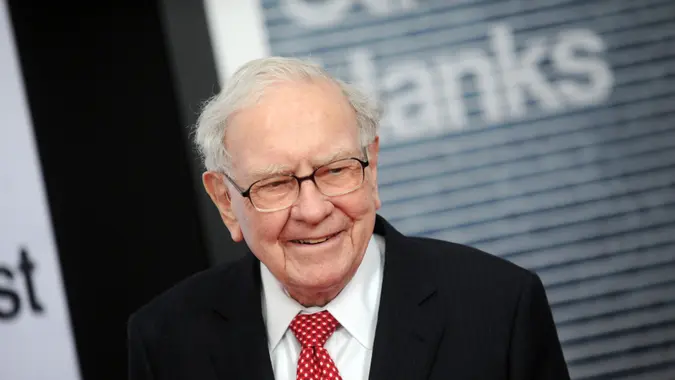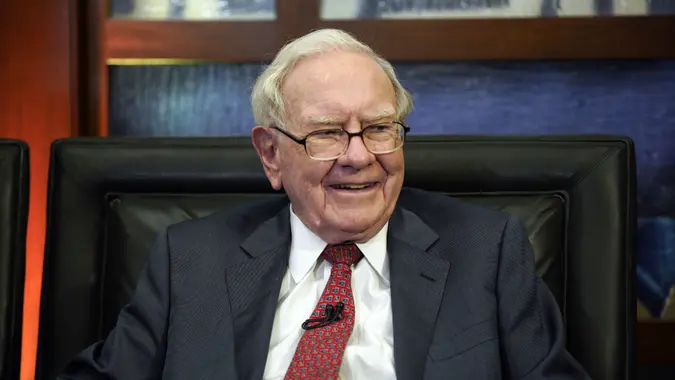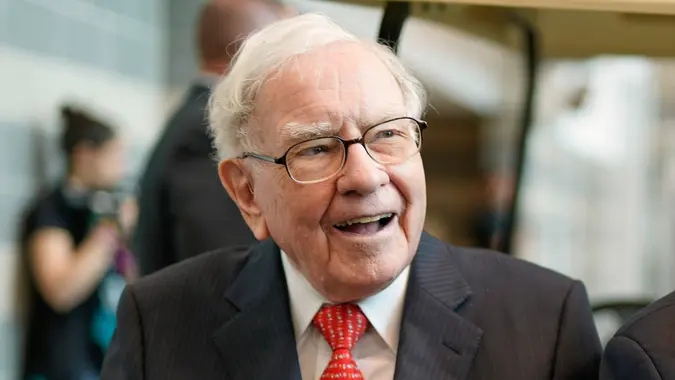Advertiser Disclosure
GOBankingRates works with many financial advertisers to showcase their products and services to our audiences. These brands compensate us to advertise their products in ads across our site. This compensation may impact how and where products appear on this site. We are not a comparison-tool and these offers do not represent all available deposit, investment, loan or credit products.
How To Get Started Investing in Your 20s
 Written by
John Csiszar
Written by
John Csiszar
 Edited by
Amen Oyiboke
Edited by
Amen Oyiboke

Commitment to Our Readers
GOBankingRates' editorial team is committed to bringing you unbiased reviews and information. We use data-driven methodologies to evaluate financial products and services - our reviews and ratings are not influenced by advertisers. You can read more about our editorial guidelines and our products and services review methodology.

20 YearsHelping You Live Richer

Reviewed by Experts

Trusted by Millions of Readers
The single best thing you can do to become a successful investor is to begin in your early 20s. Over your multi-decade investing career, you’ll have lots of winners and losers, but time is your biggest ally. Over a long time period, compound interest works its magic; so, even if you earn only below-average returns, you can still end up with a significant nest egg by the time you retire.
For example, let’s say you invest just $400 per month starting at age 21 and earn only 6% a year on your investments — well below the 10% long-term average of the stock market. If you retire at age 65, you’ll still be looking at an account value of over $1 million!
But why settle for below-average returns when there are steps you can and should take to improve your chances of investment success? Here are the best ways to get started investing in your 20s.
Establish Your Goals
When you’re out driving your car, you can’t get to your destination if you don’t know where you’re going. The same is true with investing. Before you put away your first dollar, outline what exactly you intend to achieve with your money.
Most investors have a combination of goals divided by time, such as short term, mid term and long term. For example, you might want part of your savings to go to your wedding, some to your retirement and perhaps some for your kids’ college fund. Establishing a time frame for your goals can help you pick the right investments for them.
Understand Your True Risk Tolerance
If you’ve never invested before, it’s easy to think that you can tolerate any type of market volatility, especially when you are young. While it’s true that you will have to learn to deal with the ups and downs of the market throughout your investing career, the reality is that most investors can’t stomach as much risk as they think they can.
It’s one thing to check a box on a form saying you can tolerate a 40% drop in the value of your investments; but, when it actually happens, it can be a gut-wrenching experience.
One way to test how much volatility you can handle is to watch the markets’ daily movements and use a no-risk, sample trading account that many financial firms offer. This can allow you to experience market volatility firsthand without risking any actual money.
Set Up an Emergency Fund
Most financial advisors will suggest that you set up an emergency fund before you invest for other goals. Without an emergency fund, you might end up in a financial hole right off the bat, if you have an unexpected medical expense, car repair or the like.
If you begin your financial life in debt because you don’t have an emergency fund, you may spend the rest of your life playing catch-up as your funds intended for investment are instead diverted to paying down debt.
Start Contributing to Your Workplace Retirement Plan
Probably the best investment you can make, particularly as a young investor, is to start contributing to a workplace 401(k) plan — the list of benefits is staggering.
In addition to being able to exclude your contributions from your taxable income, your employer is likely to match at least a portion of your contributions to your account. This is the closest thing to “free money” you’re likely to receive in your entire investment life. Most 401(k) plans also offer a wide range of investments to choose from, and your money grows tax-deferred.
Start an IRA
Not all employers offer 401(k) plans, so sometimes you might have to take your retirement savings into your own hands. If you’re not covered by a retirement plan at work, you can open an individual retirement account, which shares some of the benefits of a 401(k) plan.
For example, you can typically get a tax deduction on your contributions, and your investments grow tax-deferred. IRAs usually have greater freedom of choice in terms of investments, but you’re also limited as to how much you can contribute, with 2023 limits reaching just $6,500.
If you’re still in your 20s, you might want to consider a Roth IRA instead of a traditional IRA. Unlike with a traditional IRA, you won’t get a deduction on your contributions to a Roth, but you also won’t pay tax on your distributions once you retire.
Automate Your Contributions
Your 20s can be a busy time. From starting your first job to perhaps getting married, raising a family and/or buying a house, sometimes setting aside money for your investments can get lost in the shuffle.
To ensure that you are consistently building up your investment accounts, it’s a good idea to automate your contributions. This way, money is regularly taken out of your paycheck or bank account to fund your investments without you having to worry about doing it yourself. It also helps protect you from that common human instinct to spend money that’s “just sitting” in your account rather than making a conscious choice to invest it.
Keep Costs Low
One of the biggest financial benefits to smaller investors in recent years has been the advent of zero-commission trading. When you are just starting out, you don’t need to pay the high commissions charged by some full-service firms.
For starters, with a smaller portfolio, high commissions can eat up a greater percentage of your gains, making it harder to achieve your goals. But, as a younger investor, you also don’t likely need the range of services that full-service firms offer — and charge fees to access.
Find a reputable zero-commission brokerage firm for your first trades, or hand your portfolio over to a robo-advisor, who can usually allocate and monitor your investments for an annual fee of 0.25% of your assets or less.
Don’t Overtrade
The downside of commission-free trading is that it often encourages overtrading, particularly in younger and/or novice investors. Since trades don’t cost anything, it’s easy to get lured into a pattern of rapidly moving in and out of stocks. But the reality is that most day traders lose money, in spite of the headlines you might hear about how it’s a great method to “get rich quick.”
Investing consistently in quality companies over a long time period is one of the best ways to create lifelong wealth.
Invest Any ‘Found Money’
One of the best ways to rapidly pump up your investment account is to invest any “found money.” Tax refunds, year-end bonuses, inheritances and lottery winnings are all examples of “found money,” or money you weren’t planning on having.
If you can resist the urge to spend this money and invest it instead, you’ll reap significant long-term financial advantages.
Increase Your Contributions at Least Annually
When you first start investing, it can be hard to contribute a significant percentage of your salary. For one thing, your income may not be very high when you first start working. But you also aren’t yet in the habit of saving and investing, and the adjustment can take time.
To avoid getting stuck in a rut, you should commit to increasing your investment contributions at least annually, as your salary increases. For example, you might start out putting 3% of your income into your 401(k) plan, and then increase that by 1% or more per year. Some investors go so far as to increase their contribution percentage by 1% per month. By bumping up your contributions in small increments, you may not even notice the additional money going into your investments — until you reap the reward in retirement.
Share This Article:




You May Also Like




How Tangible Assets Built Barbara Corcoran's Multi-Million Dollar Portfolio
December 04, 2025
7 min Read

What the $1K in a Trump Account for Your Kid Could Grow To If You Don't Invest Anything Else
December 03, 2025
7 min Read



Why Warren Buffett Now Holds More Cash Than the Fed -- What That Signals About the Market
November 24, 2025
7 min Read


Boomers Have $472K in Investments -- Nearly Double the US Average, Study Finds
November 20, 2025
7 min Read

Self-Made Millionaire Codie Sanchez Shares the Best $1K Investment She Made
November 20, 2025
7 min Read

Buy These 4 ETFs if You Want to be Rich in 2026, According to John Liang
November 14, 2025
7 min Read

I'm a Financial Advisor: 5 Investing Tips To Combat a Frustrating Economy
November 20, 2025
7 min Read

Investment Pros Are Rebalancing Portfolios Amid Inflation Shifts: What You Can Learn
November 17, 2025
7 min Read

I'm an Investment Manager: 4 Timeless Lessons I've Learned From Warren Buffett
November 17, 2025
7 min Read
Make your money work for you
Get the latest news on investing, money, and more with our free newsletter.
By subscribing, you agree to our Terms of Use and Privacy Policy. Unsubscribe at any time.


Thanks!
You're now subscribed to our newsletter.
Check your inbox for more details.



Sending you timely financial stories that you can bank on.
Sign up for our daily newsletter for the latest financial news and trending topics.
For our full Privacy Policy, click here.
Looks like you're using an adblocker
Please disable your adblocker to enjoy the optimal web experience and access the quality content you appreciate from GOBankingRates.
- AdBlock / uBlock / Brave
- Click the ad blocker extension icon to the right of the address bar
- Disable on this site
- Refresh the page
- Firefox / Edge / DuckDuckGo
- Click on the icon to the left of the address bar
- Disable Tracking Protection
- Refresh the page
- Ghostery
- Click the blue ghost icon to the right of the address bar
- Disable Ad-Blocking, Anti-Tracking, and Never-Consent
- Refresh the page



